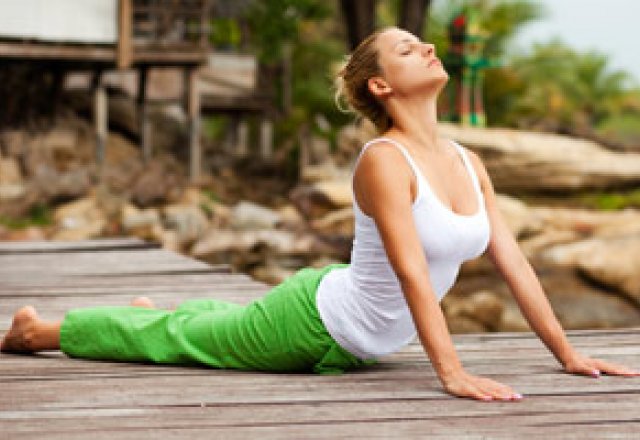
Yoga - the eight limbs

Mastering the mind is the true aim of yoga, despite what you may have gleaned from some of the modern world’s focus on bulletproof bodies and legs that can stretch behind one’s head.
Once upon a time, many centuries ago, there lived a man named Patanjali – a man who is considered the godfather of yoga. Many stories about him have taken on mythical and magical qualities to the point where he could almost be considered a deity. One story says he fell from heaven in the form of a snake into the upturned palms of his powerful yogini and goddess mother. But despite his legendary, saint-like status, we don’t really know much about this incredible historical figure.
The Yoga Sutras describe something that most Westerners know all too much about – the restless mind that runs away with itself. Mastering the mind is the true aim of yoga, despite what you may have gleaned from some of the modern world’s focus on bulletproof bodies and legs that can stretch behind one’s head. More important is the mind, and The Yoga Sutras’ eight limbs are guides to mastering it.
1. YAMA: Universal Morality
Patanjali’s ‘yamas’ are a set of morals for how we should deal with others and the world around us. They’re not so much like Moses’ Ten Commandments – they’re more aimed at helping us live more wisely and compassionately in order to return to the state of purity, bliss and happiness that Patanjali claims is our true state.
“We don't need to join an ashram to note whether we treat people with kindness or frustration. The observation of how we use our energy in relation to others and ourselves is staring at us daily,” says Melbourne yoga teacher Michelle Jayne from Yoga Ground (www.yogaground.com.au).
“What are you like on the road? How do you speak to shop assistants? How do you treat yourself when faced with a difficult task? These observations are a simple ongoing, daily experience.”
The yamas include compassion for all living things, a commitment to truthfulness, non-stealing, sense control in the sense of acting responsibly regarding sex, and neutralising the desire to hoard wealth.
2. NIYAMA: Personal Observances
The yamas described above talk about our morals in dealing with others and the outside world. The niyamas describe the way we should deal with ourselves. The niyamas ask us to remain pure and clean – both on the inside and outside. So eating clean food, maintaining a clean environment, and ensuring that we purify our organs and blood through exercise and fresh water are all incredibly important.
The niyamas also remind us to be content with what we have, remaining disciplined by keeping the body active, to study ourselves in the sense of self enquiry, and also to ensure we celebrate spirituality by recognising God or some kind of creative or universal energy.
3. ASANAS: Body Postures
Ah yes, the postures. We know these well, don’t we? The headstand, the shoulder stand, the salute to the sun sequence – the beauty and power of yoga’s asanas is what draws most of us back to our classes week after week. Exercise and strengthening the body has incredible benefits for our health, longevity, and mental wellness. Through the asanas, we develop a better understanding and awareness of our bodies and minds, as well as understanding our attitudes, sense of self, sense of balance, and how to cope with challenging situations. Asanas actually help quiet our mind, preparing us for meditation. Michelle says it’s a matter of finding the right type of practice for you.
“There is now a smorgasbord of yoga styles that is offered for people to find their path. A high majority do tend to work on the physical, simply because, from my observation, people are not present in their bodies to start with. Observation of self, meditation, requires a still enough mind so that one can view from an objective viewpoint what arises, rather than being reactive to the discoveries they make about themselves,” she says.
4. PRANAYAMA: Breathing And Control Of Prana (Life Force Energy)
Ever come to the end of a yoga class, where the asanas are finished but the breath work has not yet begun, only to see two or three of your fellow students roll up their yoga mats and dash off to some ‘more important’ engagement? According to Patanjali’s eight limbs, this is the wrong attitude. Each limb is equally as important as the others.
Breath work is fundamental to the practice of yoga during the posture work also. Pranayama goes hand in hand with the asanas in order to maximise their effectiveness. By controlling our breath as we move, yogis believe we are able to build heat in order to purify the body, and then send that energy through the chakra centres of the body to restore balance and calm.
“Through our connection to breath, we begin to dive deeply into our inner world, understanding ourselves from a different perspective, nourishing the understanding that ultimately we are all interconnected, that nothing is separate from us,” Michelle says.
5. PRATYAHARA: Control Of The Senses
Pratyahara is about retreating from the sensory world and returning to our inner self. Focusing on the outer world can be a recipe for disaster if we put too much emphasis on the noise that surrounds us constantly. Wasting physical and mental energy on trying to maximise that which gives us pleasure, and minimising that which causes us pain, creates a kind of battle that leads to us being lethargic or despondent at best, and depressed or ill at worst.
One of the best ways to control this tyranny of the senses is through meditation, when we retreat from all of the noise we hear and the colour we see, back into the inner world.
“Possibly one of the most effective ways of working the eight limbs is through meditation practice. After studying the limbs, a student is able to utilise this knowledge within an ongoing meditation practice, reflecting on their day, their experiences with the world and their beingness in the world,” Michelle says.
6. Dharana: Concentration and Cultivating Inner Perceptual Awareness
Did you grow up in the Sesame Street generation that struggles to focus for longer than a two-minute period? Get frustrated waiting in long queues or while driving? Then you may find dharana – immovable concentration of the mind – a little tricky.
This stage of the yogi or yogini’s discipline is the point where we are able to truly engage and focus upon what we are doing, rather than our energies becoming scattered in all directions. How do we do that? The trick is to focus upon something stable and practise not dwelling in the past or ruminating about the future.
Michelle admits this is difficult for the beginner.
“Dharana begins to happen with the first breath in a yoga class, with the moment you sit down to meditate,” she says.
“There is work to do in this preparation, it is not something one can achieve in a week of dedicated yoga practice. It takes a lifetime to cultivate the landscape, so patience and determination are vital along the path.”
7. DHYANA: Devotion, Meditation On The Divine
Here’s another one that may stump our largely secular, Western mindset. Dhyana, worshipping the divine, is based on the concept that when we honour deities and the universal energy, we are blessed by them and take on their attributes.
However, you don’t need to be a Hindu – or a Christian, Muslim or anything else – to follow this limb. Finding the divinity in the world around you is a way of focusing on a higher power and meditating on the realisation that you are more than your mere physical existence. Use meditation to see the world around you more clearly, and ultimately you will move towards a better understanding of the nature of reality.
8. SAMADHI: Union With The Divine
The word yoga means union, and this union refers to our connecting with pure consciousness or divinity. While we realise that most of us will never attain a Buddha-like state of enlightenment, we can certainly work on our meditation, our breath work, our morality, our behaviours, our concentration and our asanas in order to live the best life we can. The idea is that once we master the concentration of the mind, worship of the divine and union with the divine can follow.
The aim is not to master the eight limbs per se, but to live according to them for the best health and living that is available to us.
Get more advice on yoga, meditation and health. Don't forget to let us know your thoughts on Facebook!


